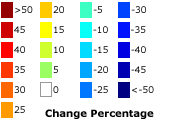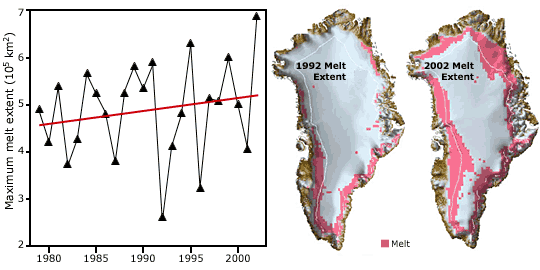

 |
|||
|
Konrad Steffen arrived on the Greenland Ice Sheet for the 2002 summer fieldwork season and immediately observed that something significant was happening in the Arctic. Pools of water already spotted the ice surface, and melting was occurring where it never had before. “That year the melt was so early and so intense — it really jumped out at me. I’d never seen the seasonal melt occur that high on the ice sheet before, and it had never started so early in the spring,” said Steffen, principal scientist and interim director at the Cooperative Institute for Research in Environmental Sciences (CIRES) at the University of Colorado.
|
May 7, 2003 | ||
|
By the end of the 2002 season, the total area of surface melt on the Greenland Ice Sheet had broken all known records. That same summer, Mark Serreze and his colleagues at the National Snow and Ice Data Center in Boulder, Colorado, began noticing unusually low levels of sea ice in the Arctic, based on remote sensing data. “I was really surprised by the change,” Serreze said. “By the end of the summer, sea ice levels in the Arctic were the lowest in decades and possibly the lowest in several centuries.” Seasonal melt areas on the Greenland Ice Sheet are generally located along the edges of the ice sheet at its lowest points. In 2002, however, the melt started unusually early and progressed higher up the ice sheet than at any time in the past 24 years. Surface melting extended up to 6,560 feet (2,000 meters) in elevation in the northeast portion of the island, where temperatures normally are too cold for melting to occur. In addition, the total melt area covered 265,000 square miles (686,350 square kilometers), representing a 16 percent increase above the maximum melt area measured in the past 24 years. Serreze’s team coincidentally discovered that in September 2002, Arctic sea ice extent was approximately 400,000 square miles (1.04 million square kilometers) less than the long-term average of 2.4 million square miles (6.2 million square kilometers), and that much of the remaining sea ice was unusually thin and spread out.
To determine whether their independent findings were related, the research teams measured the sea ice extent and ice sheet melt using passive microwave data from satellites, including data from the NIMBUS-7 Scanning Multichannel Microwave Radiometer (SMMR) (1978-1987) and its successor, the DMSP Special Sensor Microwave/Imager (SSM/I) (1987-present).
|
In this computer graphic, Greenland’s 2002 melt extent appears in pink. (Image courtesy of Konrad Steffen and Russell Huff, CIRES, University of Colorado at Boulder) | ||
|
| A researcher observes the edge of the Greenland Ice Sheet in 2001. (Image courtesy of Ted Scambos, National Snow and Ice Data Center, University of Colorado at Boulder) | ||
|
Passive microwave sensors provide data that are processed into brightness temperatures. Brightness temperatures are both a measure of the physical temperature within the snow and a gauge of emissivity, or the ability of water or ice/snow to emit radiation at the microwave frequencies (frequencies in the centimeter wavelength range). Dry snow emits much less radiation than wet snow, which behaves almost like a perfect emitter (blackbody), giving off a wide range of frequencies of radiation. Therefore, dry snow and ice have lower brightness temperatures than wet snow surfaces. The brightness temperature of seawater (ice-free ocean) is much lower than that of ice/snow or melting ice/snow. By calculating daily brightness temperatures (from the daily pass of the satellite over the Arctic), scientists can determine the extent of sea ice in the Arctic and the extent of melt on the Greenland Ice Sheet. Because the microwave instrument can “see through” clouds and darkness, ice extent can be monitored year-round, even during storms and winter darkness. To validate, or confirm, their calculations of ice extent, the sea ice team used images from the Moderate Resolution Imaging Spectroradiometer (MODIS). The Greenland team validated its findings with climatological data from 20 automatic weather stations distributed over the entire ice sheet. The passive microwave data and the MODIS images are archived at the National Snow and Ice Data Center, one of NASA’s Distributed Active Archive Centers. The Greenland team has access to year-round passive microwave data from the last 24 years for their study area, a significant observation period. During that period, Steffen documented an overall trend of increasing melt area in Greenland, taking into account years with a great deal of melt, like 2002, and years with less-than-average melt, like 1992 when the Mt. Pinatubo eruption sent aerosols into the atmosphere, which reflected solar radiation and resulted in cooler temperatures and less melt.
Steffen and Serreze believe the accelerated melt in 2002 may be linked to shifts in Northern Hemisphere atmospheric circulation patterns. Air circulation is driven by pressure differences, and in 2002 unusual stationary low-pressure areas occurred in the Arctic. A relatively stationary low-pressure cyclone over the Atlantic Ocean northeast of Greenland moved air from the North Atlantic onto the ice sheet, which is rare. While it is normal for cyclones to form over the North Atlantic, they usually are quite dynamic and are not “locked” in one place, as occurred during the summer of 2002.
|
Emissivity and Brightness Temperatures by Jason Wolfe Remote-sensing satellites measure the amount of radiance reflected or emitted by the Earth’s surface. Scientists who study the temperature of objects at the Earth’s surface need an additional factor called emissivity to accurately calculate temperature. Emissivity represents the effectiveness of different objects to radiate thermal energy and is a ratio of an object’s radiant energy to that of a blackbody at the same temperature. A blackbody is an ideal object that absorbs all incoming energy without reflecting back any energy. Given the emissivity of an object, microwave radiances are converted to brightness temperatures, which are a measure of the intensity of thermal radiation emitted by an object. |
||
|
The low sea ice levels in 2002 seem to be part of a general downward trend in Arctic sea ice over the past 24 years, which appears to be driven by a combination of higher temperatures and altered wind fields that tend to break up the ice cover. A key feature of 2002 was the persistent stormy conditions in summer, with low sea level pressure over the central Arctic Ocean from June through August. Temperatures were also unusually high from January through August. “I’ve never seen this situation occur before,” said Serreze. The unusual late winter warmth and the increased ice melt seen in the Arctic in recent years appear to be signs of a positive trend in the Arctic Oscillation (AO). The AO, which is very similar the North Atlantic Oscillation, is a large-scale atmospheric circulation phenomenon — a cyclic shifting of atmospheric mass between the Arctic and the mid-latitudes. When the AO is in a positive state, as has generally been the case for the last two decades, atmospheric pressures are low over the Arctic Ocean, winds are usually stronger than normal, and the wind transports warm air into the Arctic. Serreze explained, “Researchers at the University of Washington have shown that variations in atmospheric circulation seem to play a strong role in creating regional differences in sea ice thickness that precondition the ice for extensive summer melt and breakup. However, the stormy conditions we saw in summer 2002 don’t really fit the AO framework, so we’re still not sure why the summer was so stormy.” Steffen added, “It’s not by chance that we had the minimum sea ice distribution and the maximum melt that year; having so little sea ice affected the local climate around Greenland quite substantially. Because the sun wasn’t reflecting off the sea ice, the air close to the ocean surface was warmed, and certainly the ocean water was much warmer. This has a very strong effect on cyclones.” But were the 2002 ice minimums an indication of continual warming in the Arctic, or was 2002 just another peak in a long-term Arctic climate cycle? Warming trends have been observed over Greenland in the past, but the warming has progressed at a much slower rate. In the early 1930s, average temperatures over Greenland were as warm as those observed recently, but it took about 30 years of gradual warming to reach those levels. That warming trend could have been part of a natural, long-term cycle in the Arctic. But today, the Arctic is warming much faster, reaching current warm temperatures in less than a decade. And the warming is starting earlier in the year, with the greatest warming generally occurring in the spring and late winter.
If the warming is part of a continuing trend, higher Arctic temperatures and less ice may have long-term effects on both sea level and navigable waters in the Arctic. Steffen, Serreze, and colleagues estimate that a warmer climate over Greenland might lead to an increase in the rate of sea-level rise. Increased melt on the Greenland Ice Sheet sends more meltwater into the surrounding ocean. It also increases the rate of ice flow off Greenland, because the meltwater penetrates the ice sheet and forms a thin film between the ice and bedrock, which causes the glaciers to slide off the continent faster.
|
  In September 2002, satellite data showed that sea ice extent was 4 percent lower than any previous September since satellite monitoring began in 1978. For the period between 1987 and 2001, lower-than-average concentrations of ice floes appear in blue, and higher-than-average concentrations appear in yellow. The lavender line indicates the median ice extent for 1987 through 2001. (Image courtesy of the National Snow and Ice Data Center.) |
||
 |
|||
|
A trend in lower concentrations of Arctic sea ice may mean that historically unnavigable areas of the Arctic may open, such as the famed Northwest Passage. If current warming continues and results in lower ice concentrations, the Northwest Passage could become accessible to ice-strengthened ships, opening the area not just as a trade route, but also as a means to economically exploit the far north. This could have profound economic implications in addition to sociological implications for Arctic peoples such as the Inuit, who depend on the ice cover for travel and hunting. Some researchers, however, believe that recent Arctic warming is only a recurring peak in a long-term Arctic climate cycle. A group of Alaskan researchers recently published their assessment of Russian long-term observations of air temperature from coastal stations, and sea-ice extent and fast-ice thickness from Arctic seas. They found a great deal of variability in Arctic temperatures, with cyclic fluctuations on a timescale of 60 to 80 years. A climate cycle of this length might mean that the Arctic will cool again soon, rather than continue warming. Given these findings and the world’s interest in global climate change, long-term observations are essential to understanding Arctic climate change. “Climatologists generally need a 30-year mean (or average) to be able to talk about trends in climate variability. With the availability of data from satellites that have been in orbit for 24 years, scientists now have close to that 30-year standard, which is unique,” said Steffen. “The real question is, is this recent trend unusual?” said Serreze. Both teams will rely on the orbiting “eyes” of satellites to observe Arctic ice conditions over the next few years as they attempt to determine whether these changes are part of a long-term climate cycle or whether the Arctic is experiencing an ongoing warming trend.
|
The Greenland Ice Sheet melt area increased on average by 16 percent from 1979 to 2002. The minimum melt extent was observed after the Mt. Pinatubo eruption in 1992. (Images courtesy of Konrad Steffen and Russell Huff, CIRES, University of Colorado at Boulder)
For more information, visit Greenland Maximum Melt Extent Arctic Sea Ice Shrinking, Greenland Ice Sheet Melting, According to Study National Snow and Ice Data Center DAAC (A new browser window will open for each.) |
||